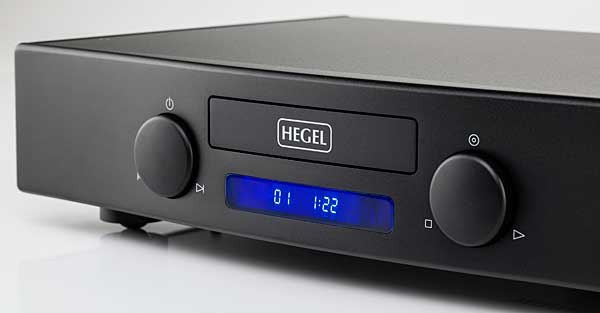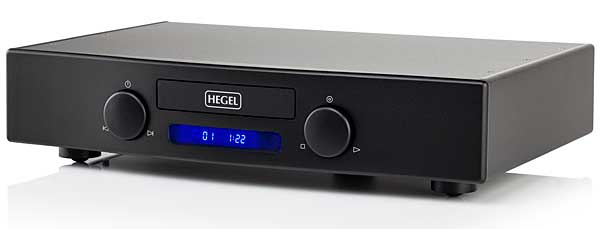| Columns Retired Columns & Blogs |
..but I just can't see buying a CD player these days especially one that costs five grand
Among the numerous encounters of Mohican and Sigur Rós I witnessed were moments, here and there, when the Hegel's usual transparency morphed into opacity, its businesslike lucidity into confusion. Overall, though, the Mohican revealed itself to be an exceptionally skilled decoder and sorter-outer.
Then and Now: In 1939, after the longest and most celebrated world tour ever, and after being praised by Jean Sibelius and Arturo Toscanini, African-American contralto Marian Anderson was denied entrance to Constitution Hall, in Washington, DC, by the venue's owners, the Daughters of the American Revolution. In 1958, President Eisenhower appointed Anderson US delegate to the Human Rights Committee of the UN. In January 1961, she sang at John F. Kennedy's inauguration. Today, I'm spellbound by and in love with Anderson's transcendent singing. From opera arias to Schubert Lieder to spirituals, I doubt any singer has made more "church" appear between my speakers. I doubt that any singer other than Nina Simone has made me feel more noble or compassionate sentiments while enjoying my hi-fi.

Listening to Schubert's "Ave Maria," from Marian Anderson (CD, RCA Victor/BMG 7911-2-RG), made me shiver in admiration for her talents, and dream in perfect step with Kosti Vehanen's well-formed piano accompaniment. The Hegel CD player conveyed every joule of Anderson's vocal energy. My head nodded slowly in meditation, marking each forward beat. Producer John Pfeiffer did an exemplary job of not dulling or sucking the life out of this compelling 1936 recording. Best of all was "Go Down, Moses"—the Mohican let the full sustain and resonance of Vehanen's piano come out, and let the close-miked presence and vibrato of Anderson's voice carry the weight and sorrow of this prayerful lament. This player was made for CDs like this.
A Multitude . . . Only a few of my friends are Keith Jarrett fans, but I'm addicted. I love watching him paint piano pictures between the speakers in my candlelit room. Stereophile's copyeditor, Richard Lehnert, rhapsodized about the originality and power of Jarrett's latest album, A Multitude of Angels, our "Recording of the Month" for January 2017 (4 CDs, ECM 2500–2503). The beautifully written and longer online version of that review concludes with: "This music of astonishing generosity is the best thing he's done."
I bought A Multitude of Angels right away, and now I am powerless to remove it from the Mohican's disc drawer. The Hegel made Jarrett's inventions easy to recognize and appreciate. Listening to Jarrett create art on the run is like watching time-lapse images of a mountain being formed. With the Mohican, I sat motionless, my brain aloft, watching him discover and build—then destroy and re-create. His fluid matrices of passionately engineered musical forms danced before me. His breathing and foot tapping were solidly portrayed.
Jarrett himself recorded these four long-form improvisations, using a pair of B&K omni microphones and a Sonosax DAT machine. (He pushed Record before walking onstage.) RL thinks the recording is dry, and perhaps it is. But its simple, unobstructed clarity lets me feel closer than usual to Jarrett's well-tempered mind.
The Mohican played A Multitude of Angels in a conspicuously straightforward, plain-truth way—maybe to a fault. Bent Holter's CD player delivered solid, authentic-sounding timbres and workmanlike forward progressions—extremely important with Jarrett—but also seemed to very slightly dull leading and trailing edges of piano notes. I could sense the piano's soundboard, but only when I listened for it. Wooden hammers sounded like wooden hammers, but slightly muted and recessed. Jarrett's voice seemed slightly distant. RL said the mikes were placed "about 10' in front of the piano" (footnote 1); through the Mohican, it sounded like 15'.
Comparison: Mytek's HiFi Brooklyn
To further investigate, I decided to bypass the Hegel's D/A converter, and connect its digital output to Mytek's Brooklyn DAC ($1999). The Brooklyn "moved" Jarrett's mikes to within 5' of his piano. I could feel the size and mass of the soundboard. I could revel in the long note decays. Transient attacks, hammers contacting strings, keys moving down and hitting the keybed, Jarrett's vocalizations—all were better articulated and more palpable. The pianist's foot tapped with enhanced leather-meets-wood realism. The sounds of applause were better focused and finer grained, with greater energy and volume. With the Mohican's disc transport and its Holter-designed servos feeding the Mytek Brooklyn, I felt more right-brain giddiness and lively kinetic energy than I had with the Mohican alone.

Hoping to capitalize on this Mytek-enhanced vividness, I played and slipped deeply into J.S. Bach's St. Matthew Passion, as rendered by Nikolaus Harnoncourt and Concentus Musicus Wien (3 CDs, Teldec 2292-42509-2). Two nights in a row, I fell asleep to its broad sonic textures. The other side of the room was a giant soundstage, while soloists of the Vienna Boys' Choir stood near my bed, their voices pure and powerful. Dynamic shifts were frequently startling. As I lay there in the dark, the Mohican-Brooklyn combo kept my attentions on the recording space, and on the hope and sorrow of the Passion according to Matthew.
Then I returned to Takk . . . by Sigur Rós.
Before this change of DACs, I'd thought the Mohican's best traits were its excellent tone character, strong boogie factor, and benign enjoyableness. I'd thought the Mytek Brooklyn's best traits were transparency and low-distortion neutrality, and its ability to process every kind of digital file, including MQA. I didn't realize how much high-energy varoom and scintillating space the Mytek could deliver. With the Hegel transport and Brooklyn DAC, the music of Sigur Rós seemed to jump out of my DeVore O/93s and forcefully occupy the space in my room. This effect was so dramatic that it left me no choice but to remove the Brooklyn and play Takk . . . once more—this time through only the Mohican.
Alone, the Hegel sounded smooth, solid, and organically truthful, but, all the way through Takk's first three tracks I kept turning the volume up and up, in hopes of generating that same kinetic presence the Mytek had put out. Alas, the Mohican never achieved it. However! I rediscovered a beguiling corporeality that I'd noticed earlier but hadn't fully appreciated.
Comparison: Schiit's Yggdrasil
Intrigued, I felt compelled to hear how Bent Holter's DAC would compare with another Old Norse legend: the Yggdrasil DAC from Schiit Audio ($2299) Right away, I was surprised: The Yggdrasil sounded considerably more textured than the Mohican. The spaces between notes were grayer and fuzzier than the Hegel's stoic emptiness. The Yggdrasil reproduced Harnoncourt's St. Matthew Passion as larger and more forceful than did the Mohican, but it lacked the transparency and neutrality of the standalone Hegel. Overall, the Yggdrasil's sound seemed too colorful and forceful, the Mohican a little too reserved. Nevertheless, with every CD, I preferred the less flashy, more well-mannered temperament of the Hegel alone.
Summing Up
Listening with Schiit Yggdrasil and Mytek Brooklyn made me realize just how fundamentally neutral and effective were the Mohican's transport, servos, DAC, and analog stages. When I describe the Hegel CD player as "well mannered," I don't mean boring or stiff. I just mean that it didn't make recordings sound more energetic than they are—and that it may have made some recordings sound a tad less spirited than they actually are. As always, truth and neutrality remain in the ears of the beholder.
The Hegel Mohican played all my CDs so fundamentally well that I kept thinking, "Okay, it's a computer-audio denier, and it's not a dCS Rossini, but if I had to live forever with this lone survivor of a once-noble race—I could.
Only seven?
Hegel Music Systems' Mohican might give new meaning to that old cliché: future-proof. Surely, many of you probably judged the Mohican to be "obsolete," or worse, before you even finished reading my description of it. But that's what they said about my Marantz tube gear in the 1970s, my Garrard 301 turntable (and my LPs!) in the '80s, and my Ampex reel-to-reel recorders (and my master tapes!!) in the '90s.
With digital playback today, the only guarantors of future proofing are high quality of sound, high quality of construction, and enduring quantity of available program. Possessing the first two criteria in equal measure, the Hegel Mohican is unquestionably future-proof. It looks and feels extremely well built, and, most important, it delivers a quality of sound that would well serve an astute, music-loving CD collector for decades to come.

..but I just can't see buying a CD player these days especially one that costs five grand

I would buy one if it had capacity to connect from external sources to its DAC. If not, not sure why anyone would pay $5k for a CD player without that feature. Even a late adopter like myself to computer audio now sees the need for all new CD players to offer. Still, nice machine and quality made in Norway, suppose Hegel thinks there are still people who only listen to CD's, in fact, they are not the only manufacturers that offer a stand alone CD player, I recall Parasound offering a CD player without any inputs for external computer sources, wonder how well they sell. I do hope Hegel sells more than seven.

I am right there with ya- HR.
I collect 1st pressing CDs for the same reason you collect the Vinyl editions. Very nice coverage and review of the Hegel cd spinner.
Good to read about it being made in Norway and NOT junk-sourced to china (like so many of its competitors).

..but the way I listen is ripping them and loading on a NAS drive connected to a music server. Much easier to navigate your music and with a super high quality DAC better sound..

Mr. Reichert: Now this (review) was much better; deftly navigating the torturous waters of both reviewing sensitivity and drawing comparisons.
But here, you've done reasonably well (as opposed to the other one I lambasted you on).
It would have been instructive if you experimented with PC's, IC's or other combinations with the Hegel Mohican.
I'm not even sure if you referenced the DAC-chip employed , or any other notable feature of the Mohican. I don't recall anything memorable.
In any case, the rightful 'takeaway' from this review is that the very 'up-to-date" Mytek "Brooklyn" slapped the Mohican back into yester-century, at less than half the price of the clearly over-priced Hegel.
Perhaps that eager show "smile" was meant to soften you up to some nice words about the Mohican, I'm pleased to see you did both that, and the right thing in drawing some comparisons.
peter jasz